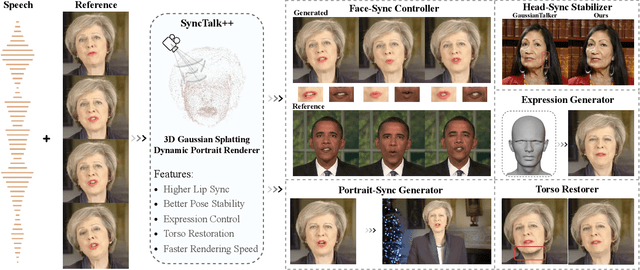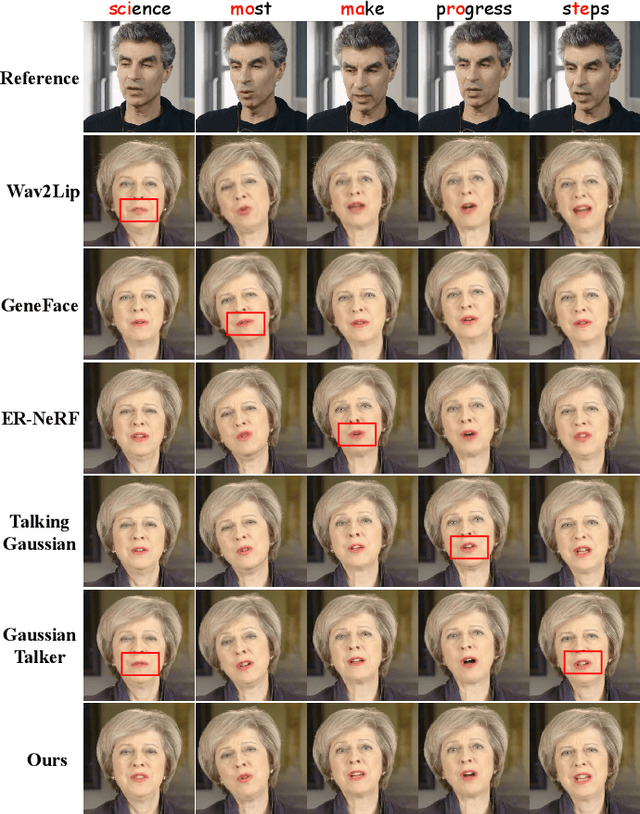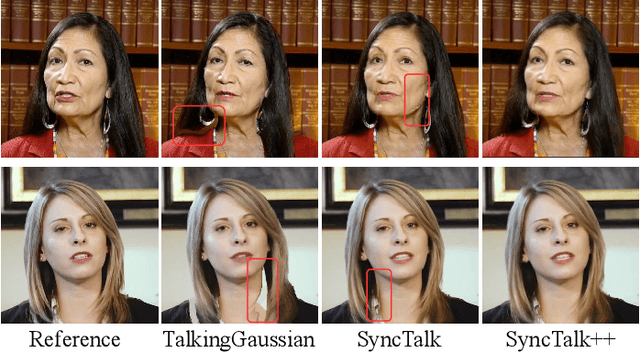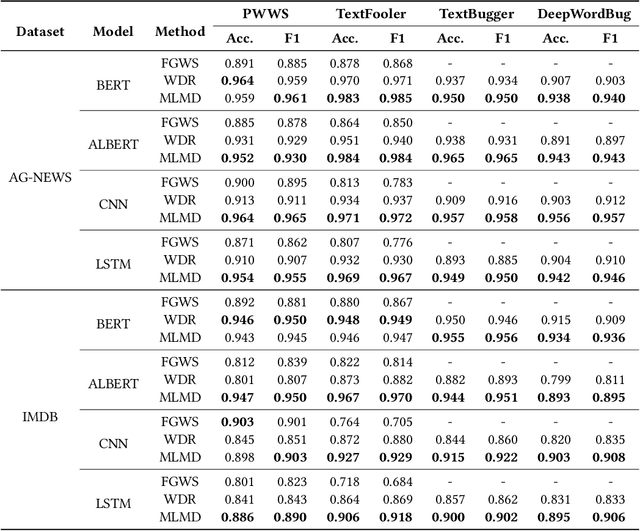Xiaomei Zhang
Character-Level Perturbations Disrupt LLM Watermarks
Sep 11, 2025Abstract:Large Language Model (LLM) watermarking embeds detectable signals into generated text for copyright protection, misuse prevention, and content detection. While prior studies evaluate robustness using watermark removal attacks, these methods are often suboptimal, creating the misconception that effective removal requires large perturbations or powerful adversaries. To bridge the gap, we first formalize the system model for LLM watermark, and characterize two realistic threat models constrained on limited access to the watermark detector. We then analyze how different types of perturbation vary in their attack range, i.e., the number of tokens they can affect with a single edit. We observe that character-level perturbations (e.g., typos, swaps, deletions, homoglyphs) can influence multiple tokens simultaneously by disrupting the tokenization process. We demonstrate that character-level perturbations are significantly more effective for watermark removal under the most restrictive threat model. We further propose guided removal attacks based on the Genetic Algorithm (GA) that uses a reference detector for optimization. Under a practical threat model with limited black-box queries to the watermark detector, our method demonstrates strong removal performance. Experiments confirm the superiority of character-level perturbations and the effectiveness of the GA in removing watermarks under realistic constraints. Additionally, we argue there is an adversarial dilemma when considering potential defenses: any fixed defense can be bypassed by a suitable perturbation strategy. Motivated by this principle, we propose an adaptive compound character-level attack. Experimental results show that this approach can effectively defeat the defenses. Our findings highlight significant vulnerabilities in existing LLM watermark schemes and underline the urgency for the development of new robust mechanisms.
HieroAction: Hierarchically Guided VLM for Fine-Grained Action Analysis
Aug 23, 2025Abstract:Evaluating human actions with clear and detailed feedback is important in areas such as sports, healthcare, and robotics, where decisions rely not only on final outcomes but also on interpretable reasoning. However, most existing methods provide only a final score without explanation or detailed analysis, limiting their practical applicability. To address this, we introduce HieroAction, a vision-language model that delivers accurate and structured assessments of human actions. HieroAction builds on two key ideas: (1) Stepwise Action Reasoning, a tailored chain of thought process designed specifically for action assessment, which guides the model to evaluate actions step by step, from overall recognition through sub action analysis to final scoring, thus enhancing interpretability and structured understanding; and (2) Hierarchical Policy Learning, a reinforcement learning strategy that enables the model to learn fine grained sub action dynamics and align them with high level action quality, thereby improving scoring precision. The reasoning pathway structures the evaluation process, while policy learning refines each stage through reward based optimization. Their integration ensures accurate and interpretable assessments, as demonstrated by superior performance across multiple benchmark datasets. Code will be released upon acceptance.
Pose-RFT: Enhancing MLLMs for 3D Pose Generation via Hybrid Action Reinforcement Fine-Tuning
Aug 11, 2025Abstract:Generating 3D human poses from multimodal inputs such as images or text requires models to capture both rich spatial and semantic correspondences. While pose-specific multimodal large language models (MLLMs) have shown promise in this task, they are typically trained with supervised objectives such as SMPL parameter regression or token-level prediction, which struggle to model the inherent ambiguity and achieve task-specific alignment required for accurate 3D pose generation. To address these limitations, we propose Pose-RFT, a reinforcement fine-tuning framework tailored for 3D human pose generation in MLLMs. We formulate the task as a hybrid action reinforcement learning problem that jointly optimizes discrete language prediction and continuous pose generation. To this end, we introduce HyGRPO, a hybrid reinforcement learning algorithm that performs group-wise reward normalization over sampled responses to guide joint optimization of discrete and continuous actions. Pose-RFT further incorporates task-specific reward functions to guide optimization towards spatial alignment in image-to-pose generation and semantic consistency in text-to-pose generation. Extensive experiments on multiple pose generation benchmarks demonstrate that Pose-RFT significantly improves performance over existing pose-specific MLLMs, validating the effectiveness of hybrid action reinforcement fine-tuning for 3D pose generation.
SyncTalk++: High-Fidelity and Efficient Synchronized Talking Heads Synthesis Using Gaussian Splatting
Jun 17, 2025



Abstract:Achieving high synchronization in the synthesis of realistic, speech-driven talking head videos presents a significant challenge. A lifelike talking head requires synchronized coordination of subject identity, lip movements, facial expressions, and head poses. The absence of these synchronizations is a fundamental flaw, leading to unrealistic results. To address the critical issue of synchronization, identified as the ''devil'' in creating realistic talking heads, we introduce SyncTalk++, which features a Dynamic Portrait Renderer with Gaussian Splatting to ensure consistent subject identity preservation and a Face-Sync Controller that aligns lip movements with speech while innovatively using a 3D facial blendshape model to reconstruct accurate facial expressions. To ensure natural head movements, we propose a Head-Sync Stabilizer, which optimizes head poses for greater stability. Additionally, SyncTalk++ enhances robustness to out-of-distribution (OOD) audio by incorporating an Expression Generator and a Torso Restorer, which generate speech-matched facial expressions and seamless torso regions. Our approach maintains consistency and continuity in visual details across frames and significantly improves rendering speed and quality, achieving up to 101 frames per second. Extensive experiments and user studies demonstrate that SyncTalk++ outperforms state-of-the-art methods in synchronization and realism. We recommend watching the supplementary video: https://ziqiaopeng.github.io/synctalk++.
Unveiling Hidden Vulnerabilities in Digital Human Generation via Adversarial Attacks
Apr 24, 2025



Abstract:Expressive human pose and shape estimation (EHPS) is crucial for digital human generation, especially in applications like live streaming. While existing research primarily focuses on reducing estimation errors, it largely neglects robustness and security aspects, leaving these systems vulnerable to adversarial attacks. To address this significant challenge, we propose the \textbf{Tangible Attack (TBA)}, a novel framework designed to generate adversarial examples capable of effectively compromising any digital human generation model. Our approach introduces a \textbf{Dual Heterogeneous Noise Generator (DHNG)}, which leverages Variational Autoencoders (VAE) and ControlNet to produce diverse, targeted noise tailored to the original image features. Additionally, we design a custom \textbf{adversarial loss function} to optimize the noise, ensuring both high controllability and potent disruption. By iteratively refining the adversarial sample through multi-gradient signals from both the noise and the state-of-the-art EHPS model, TBA substantially improves the effectiveness of adversarial attacks. Extensive experiments demonstrate TBA's superiority, achieving a remarkable 41.0\% increase in estimation error, with an average improvement of approximately 17.0\%. These findings expose significant security vulnerabilities in current EHPS models and highlight the need for stronger defenses in digital human generation systems.
Exploring Gradient-Guided Masked Language Model to Detect Textual Adversarial Attacks
Apr 08, 2025Abstract:Textual adversarial examples pose serious threats to the reliability of natural language processing systems. Recent studies suggest that adversarial examples tend to deviate from the underlying manifold of normal texts, whereas pre-trained masked language models can approximate the manifold of normal data. These findings inspire the exploration of masked language models for detecting textual adversarial attacks. We first introduce Masked Language Model-based Detection (MLMD), leveraging the mask and unmask operations of the masked language modeling (MLM) objective to induce the difference in manifold changes between normal and adversarial texts. Although MLMD achieves competitive detection performance, its exhaustive one-by-one masking strategy introduces significant computational overhead. Our posterior analysis reveals that a significant number of non-keywords in the input are not important for detection but consume resources. Building on this, we introduce Gradient-guided MLMD (GradMLMD), which leverages gradient information to identify and skip non-keywords during detection, significantly reducing resource consumption without compromising detection performance.
MVBoost: Boost 3D Reconstruction with Multi-View Refinement
Nov 26, 2024Abstract:Recent advancements in 3D object reconstruction have been remarkable, yet most current 3D models rely heavily on existing 3D datasets. The scarcity of diverse 3D datasets results in limited generalization capabilities of 3D reconstruction models. In this paper, we propose a novel framework for boosting 3D reconstruction with multi-view refinement (MVBoost) by generating pseudo-GT data. The key of MVBoost is combining the advantages of the high accuracy of the multi-view generation model and the consistency of the 3D reconstruction model to create a reliable data source. Specifically, given a single-view input image, we employ a multi-view diffusion model to generate multiple views, followed by a large 3D reconstruction model to produce consistent 3D data. MVBoost then adaptively refines these multi-view images, rendered from the consistent 3D data, to build a large-scale multi-view dataset for training a feed-forward 3D reconstruction model. Additionally, the input view optimization is designed to optimize the corresponding viewpoints based on the user's input image, ensuring that the most important viewpoint is accurately tailored to the user's needs. Extensive evaluations demonstrate that our method achieves superior reconstruction results and robust generalization compared to prior works.
Large Language Model Watermark Stealing With Mixed Integer Programming
May 30, 2024Abstract:The Large Language Model (LLM) watermark is a newly emerging technique that shows promise in addressing concerns surrounding LLM copyright, monitoring AI-generated text, and preventing its misuse. The LLM watermark scheme commonly includes generating secret keys to partition the vocabulary into green and red lists, applying a perturbation to the logits of tokens in the green list to increase their sampling likelihood, thus facilitating watermark detection to identify AI-generated text if the proportion of green tokens exceeds a threshold. However, recent research indicates that watermarking methods using numerous keys are susceptible to removal attacks, such as token editing, synonym substitution, and paraphrasing, with robustness declining as the number of keys increases. Therefore, the state-of-the-art watermark schemes that employ fewer or single keys have been demonstrated to be more robust against text editing and paraphrasing. In this paper, we propose a novel green list stealing attack against the state-of-the-art LLM watermark scheme and systematically examine its vulnerability to this attack. We formalize the attack as a mixed integer programming problem with constraints. We evaluate our attack under a comprehensive threat model, including an extreme scenario where the attacker has no prior knowledge, lacks access to the watermark detector API, and possesses no information about the LLM's parameter settings or watermark injection/detection scheme. Extensive experiments on LLMs, such as OPT and LLaMA, demonstrate that our attack can successfully steal the green list and remove the watermark across all settings.
SyncTalk: The Devil is in the Synchronization for Talking Head Synthesis
Nov 29, 2023Abstract:Achieving high synchronization in the synthesis of realistic, speech-driven talking head videos presents a significant challenge. Traditional Generative Adversarial Networks (GAN) struggle to maintain consistent facial identity, while Neural Radiance Fields (NeRF) methods, although they can address this issue, often produce mismatched lip movements, inadequate facial expressions, and unstable head poses. A lifelike talking head requires synchronized coordination of subject identity, lip movements, facial expressions, and head poses. The absence of these synchronizations is a fundamental flaw, leading to unrealistic and artificial outcomes. To address the critical issue of synchronization, identified as the "devil" in creating realistic talking heads, we introduce SyncTalk. This NeRF-based method effectively maintains subject identity, enhancing synchronization and realism in talking head synthesis. SyncTalk employs a Face-Sync Controller to align lip movements with speech and innovatively uses a 3D facial blendshape model to capture accurate facial expressions. Our Head-Sync Stabilizer optimizes head poses, achieving more natural head movements. The Portrait-Sync Generator restores hair details and blends the generated head with the torso for a seamless visual experience. Extensive experiments and user studies demonstrate that SyncTalk outperforms state-of-the-art methods in synchronization and realism. We recommend watching the supplementary video: https://ziqiaopeng.github.io/synctalk
Masked Language Model Based Textual Adversarial Example Detection
Apr 19, 2023



Abstract:Adversarial attacks are a serious threat to the reliable deployment of machine learning models in safety-critical applications. They can misguide current models to predict incorrectly by slightly modifying the inputs. Recently, substantial work has shown that adversarial examples tend to deviate from the underlying data manifold of normal examples, whereas pre-trained masked language models can fit the manifold of normal NLP data. To explore how to use the masked language model in adversarial detection, we propose a novel textual adversarial example detection method, namely Masked Language Model-based Detection (MLMD), which can produce clearly distinguishable signals between normal examples and adversarial examples by exploring the changes in manifolds induced by the masked language model. MLMD features a plug and play usage (i.e., no need to retrain the victim model) for adversarial defense and it is agnostic to classification tasks, victim model's architectures, and to-be-defended attack methods. We evaluate MLMD on various benchmark textual datasets, widely studied machine learning models, and state-of-the-art (SOTA) adversarial attacks (in total $3*4*4 = 48$ settings). Experimental results show that MLMD can achieve strong performance, with detection accuracy up to 0.984, 0.967, and 0.901 on AG-NEWS, IMDB, and SST-2 datasets, respectively. Additionally, MLMD is superior, or at least comparable to, the SOTA detection defenses in detection accuracy and F1 score. Among many defenses based on the off-manifold assumption of adversarial examples, this work offers a new angle for capturing the manifold change. The code for this work is openly accessible at \url{https://github.com/mlmddetection/MLMDdetection}.
 Add to Chrome
Add to Chrome Add to Firefox
Add to Firefox Add to Edge
Add to Edge